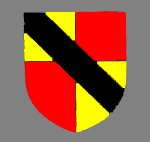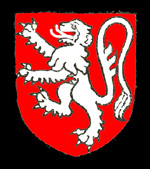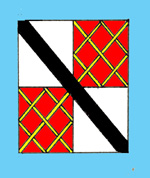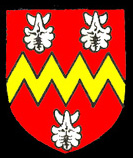The Manor of Bromham alias Brayes

Arms of the Barony of Bedford
Volume III of The Victoria County History for Bedfordshire was published in 1912 and gives the history of manors in Bromham. The compilers of the history relate that Bromham or Brayes Manor had its origin in the large manor held by Hugh de Beauchamp, later Baron of Bedford, in 1086.
Beauchamp’s descendant John de Beauchamp was killed fighting for Simon de Montfort against King Henry III (1216-1272) at the Battle of Evesham in 1265. His possessions, including the Manor of Bromham, were to be divided between his heirs, his three sisters. His mother Amicia retained the manor until her death in 1278 when it was divided between the three sisters.

Arms of the de Moubray family
Brayes Manor passed to Maud Beauchamp who married Roger de Moubray. His other two sisters were Ela, who had a division of the original Bromham Manor later known as Wakes and Beatrice who had the portion which formed the second Bromham Manor. After the death of Roger de Moubray Maud married Sir Robert Lestrange who died in 1312. Maud's heir was her grandson from her first marriage John de Moubray who settled the manor on his father-in-law William de Braose, of Bramber [Sussex] for life in 1316.

The Despenser arms
John de Moubray joined the rebellion of Earl Thomas of Lancaster against King Edward II (1307-1327) in 1321 and was captured at the Earl Thomas' defeat at the Battle of Boroughbridge; he was soon afterwards hanged as a traitor at York. Edward II's favourite and, possible lover, Hugh le Despenser was, inevitably, granted de Moubray's former manors in the same year. He was executed for treason in 1326 and all his estates reverted to the Crown. On Edward II's murder in 1327 the manor reverted to the de Moubray family and to John's son, another John. This John died in 1361 by which time the manor was worth the considerable sum of £20 per annum.
The de Moubray family continued to hold Brayes Manor until 1488. A John de Moubray, lord of the manor, was created Earl of Nottingham in 1377 and died in 1383. His brother Thomas succeeded to the manor and he was created Earl and Duke of Norfolk. He was only duke for two years, being created in 1397 and being forced into exile for treason the following year. He died of plague in Venice in 1399 and the title of Duke of Norfolk died with him. He was also Earl of Norfolk, succeeding to this separate title on the death of his grandmother in the year of his own death. His son Thomas succeeded him as Earl of Norfolk and his brother John was again created Duke of Norfolk in 1425. The dukedom, Manor of Brayes and Earldom of Nottingham all followed the same succession. The dukedom, The Earldom of Nottingham and Brayes Manor passed to Richard, Duke of York, second son of King Edward IV (1461-1483) and one of the Princes in the Tower in 1476. In 1483 the Earldom of Nottingham and Brayes Manor passed to William, Viscount Berkeley. He sold the manor to Sir Reginald Bray in 1488.

The Bray family arms
The Bray family held the manor until 1565 when Edmund, Sir Reginald’s grandson sold it to Sir Lewis Dyve, who already possessed the Manors of (acquired in 1553) and Wakes (acquired in 1555). The manor remained in the Dyve family until 1708, despite the sequestration of the estates of the prominent Royalist Sir Lewis Dyve by parliament towards the end of the first civil war in 1645.

The Dyve family arms
It was another Lewis Dyve who sold the manor, to Sir Thomas Trevor, Chief Justice of the Common Pleas, in 1708 for £21,394/2/6. Trevor became Baron Trevor of Bromham in 1712. The 4th Baron Trevor, under the terms of the will of his maternal great grandfather John Hampden, assumed the surname Hampden and in 1776 was created 1st Viscount Hampden. It is ironic that the ownership of Bromham Hall and the various manors passed from the descendents of a prominent Royalist, Sir Lewis Dyve, to those of a prominent Parliamentarian, John Hampden, a chief opponent of Charles I’s Ship Money tax who was killed at the Battle of Chalgrove Field in 1643. The viscount was succeeded by his first, then his second son, the latter dying childless in 1824 when the manors passed to a kinsman Hon. George Rice Rice, son and heir of the 3rd Baron Dynevor, who succeeded to his father’s title in 1852 when the manor passed to his daughter Miss Rice Trevor and, at her death to her great-nephew Trevor Wingfield who was lord of the manor into the 20th century.

Arms of the Viscounts Hampden
A succession of Law of Property Acts in the 1920s extinguished all manorial incidents, courts and copyhold tenure of land. This effectively abolished manors in all but name.